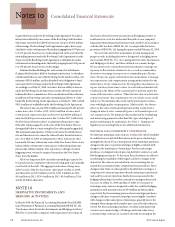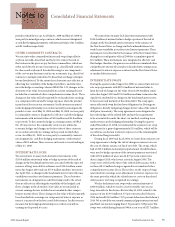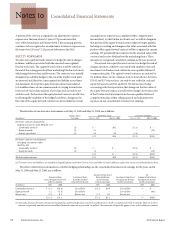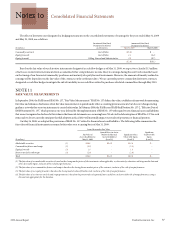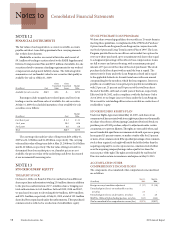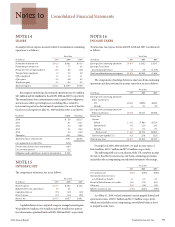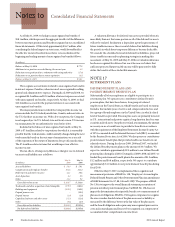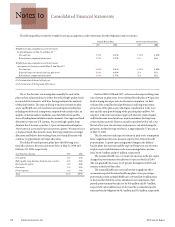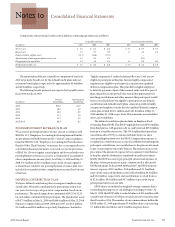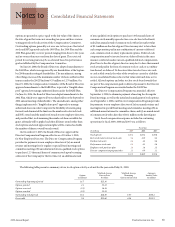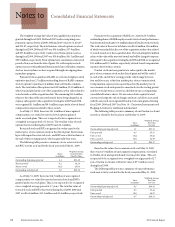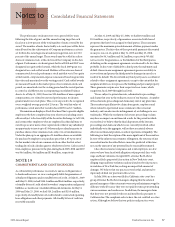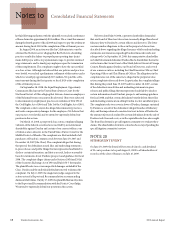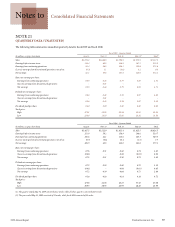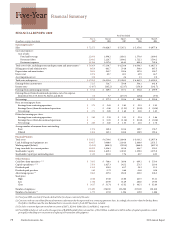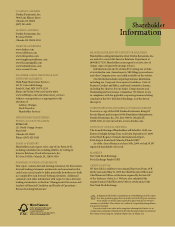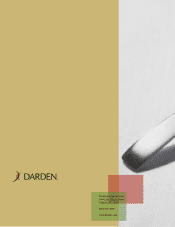Red Lobster 2009 Annual Report Download - page 65
Download and view the complete annual report
Please find page 65 of the 2009 Red Lobster annual report below. You can navigate through the pages in the report by either clicking on the pages listed below, or by using the keyword search tool below to find specific information within the annual report.
2009 Annual Report Darden Restaurants, Inc. 63
Notes to Consolidated Financial Statements
Components of net periodic benefit cost included in continuing operations are as follows:
Defined Benefit Plans Postretirement Benefit Plan
(In millions)
2009 2008 2007 2009 2008 2007
Service cost $ 6.0 $ 6.1 $ 6.0 $ 0.7 $ 0.7 $ 0.7
Interest cost 9.9 9.7 9.0 1.7 1.2 1.0
Expected return on plan assets (16.3) (14.8) (13.7) – – –
Amortization of unrecognized prior service cost 0.2 0.1 0.1 – (0.1) –
Recognized net actuarial loss 0.4 4.3 5.4 0.6 0.3 0.2
Net periodic benefit cost $ 0.2 $ 5.4 $ 6.8 $ 3.0 $ 2.1 $ 1.9
The amortization of the net actuarial loss component of our fiscal
2010 net periodic benefit cost for the defined benefit plans and post-
retirement benefit plan is expected to be approximately $0.4 million
and $0.6 million, respectively.
The following benefit payments are expected to be paid between
fiscal 2010 and fiscal 2019:
Defined Postretirement
(In millions)
Benefit Plans Benefit Plan
2010 $11.6 $1.0
2011 10.2 1.0
2012 10.6 0.9
2013 11.1 1.0
2014 11.7 1.2
2015-2019 68.5 8.3
POSTEMPLOYMENT SEVERANCE PLAN
We accrue for postemployment severance costs in accordance with
SFAS No. 112, “Employers’ Accounting for Postemployment Benefits –
an amendment of FASB Statements No. 5 and 43,” and use guidance
found in SFAS No. 106, “Employers’ Accounting for Postretirement
Benefits Other Than Pensions,” to measure the cost recognized in our
consolidated financial statements. As a result, we use the provisions
of SFAS No. 158 to recognize actuarial gains and losses related to our
postemployment severance accrual as a component of accumulated
other comprehensive income (loss). As of May 31, 2009 and May 25,
2008, $4.5 million and $5.4 million, respectively, of unrecognized
actuarial losses related to our postemployment severance plan were
included in accumulated other comprehensive income (loss) on a net
of tax basis.
DEFINED CONTRIBUTION PLAN
We have a defined contribution plan covering most employees age
21 and older. We match contributions for participants with at least
one year of service up to six percent of compensation, based on our
performance. The match ranges from a minimum of $0.25 to $1.20
for each dollar contributed by the participant. The plan had net assets
of $477.9 million at May 31, 2009 and $469.0 million at May 25, 2008.
Expense recognized in fiscal 2009, 2008 and, 2007 was $2.0 million,
$1.3 million and $0.8 million, respectively. Employees classified as
“highly compensated” under the Internal Revenue Code are not
eligible to participate in this plan. Instead, highly compensated
employees are eligible to participate in a separate non-qualified
deferred compensation plan. This plan allows eligible employees
to defer the payment of part of their annual salary and all or part of
their annual bonus and provides for awards that approximate the
matching contributions and other amounts that participants would
have received had they been eligible to participate in our defined
contribution and defined benefit plans. Amounts payable to highly
compensated employees under the non-qualified deferred compen-
sation plan totaled $132.1 million and $143.8 million at May 31,
2009 and May 25, 2008, respectively. These amounts are included in
other current liabilities.
The defined contribution plan includes an Employee Stock
Ownership Plan (ESOP). This ESOP originally borrowed $50.0 million
from third parties, with guarantees by us, and borrowed $25.0 million
from us at a variable interest rate. The $50.0 million third party loan
was refinanced in 1997 by a commercial bank’s loan to us and a
corresponding loan from us to the ESOP. Compensation expense is
recognized as contributions are accrued. In addition to matching plan
participant contributions, our contributions to the plan are also made
to pay certain employee incentive bonuses. Fluctuations in our stock
price impact the amount of expense to be recognized. Contributions
to the plan, plus the dividends accumulated on unallocated shares
held by the ESOP, are used to pay principal, interest and expenses of
the plan. As loan payments are made, common stock is allocated to
ESOP participants. In fiscal 2009, 2008 and 2007, the ESOP incurred
interest expense of $0.3 million, $0.9 million and $1.2 million,
respectively, and used dividends received of $1.8 million, $4.4 million
and $3.6 million, respectively, and contributions received from us
of $2.4 million, $0.0 million and $0.7 million, respectively, to pay
principal and interest on our debt.
ESOP shares are included in weighted-average common shares
outstanding for purposes of calculating net earnings per share. At
May 31, 2009, the ESOP’s debt to us had a balance of $11.6 million with
a variable rate of interest of 0.69 percent and is due to be repaid no later
than December 2014. The number of our common shares held in the
ESOP at May 31, 2009 approximated 5.9 million shares, representing
3.7 million allocated shares and 2.2 million suspense shares.



